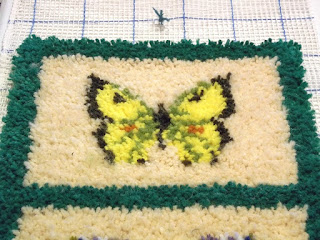 |
| Vintage Swedish weaving example |
Here is another example of Swedish weaving or huck embroidery. It is worked selvage-to-selvage on pale pink huck toweling in red and shades of violet embroidery floss. It could easily have been done with other materials, such as cotton crochet thread or fine acrylic yarn. As you can see, the patterns of spires are worked alternately in both directions. A square this size is suitable for a decorative pillow top.
Below are more patterns done on huck toweling. Some are linear, while others are all-over designs. You can repeat elements of a design indefinitely to make wider borders or cover larger pieces of fabric. You can also combine elements of two or more designs to make a more intricate design. Try several. Who knows? You may come up with a unique design of your own.
If you don't have appropriate fabric on which to practice your stitches, try doing them on plastic canvas. Look closely at the samples of pattern darning shown below. See how the two exposed bars of plastic resemble the two “floats” on the huck fabric? Note how this very simple design changes when you do it in one, two, or three colors. You can practice many linear designs on plastic canvas. Your samples will be durable and easy to file for future reference. Also, it is easy to pull the yarn out if you make a mistake. Diagonal designs are more difficult, but many can be done with a little practice.
In the first post of this series, I mentioned in the introduction that this type of embroidery could be done on a number of fabrics other than huck toweling. My first choice for this would be Aida cloth. The fabric seen here is #14 Aida, the most popular and readily available kind. It comes in a large range of colors. It is most commonly used for counted cross-stitch, but is useful for a number of other techniques. The set of stitch patterns on this piece of gold Aida were adapted from samples used in describing Holbein embroidery. Be careful with the pattern done in orange: it is more difficult than it seems.
To make the stitches, run the tip of your needle under the small squares made by the weave of the Aida cloth, just as you would under the “floats” of the huck. Some needleworkers recommend that you pick up only the center pair of threads in each square, to make it more like picking up the huck “floats”. You may want to try this for yourself. At this small scale, I prefer to pick up the entire square of four threads. The fabric is double-layered, allowing you to keep all your stitches on the surface of the fabric as you do with huck. It takes some practice, however, to pick up only the top layer of threads, leaving the bottom layer undisturbed. It is important to keep your stitches level as you do repeat motifs like the stepped diamonds done in green on the gold Aida. Because the squares on the Aida cloth are so small, it is easy to accidentally move up or down and stitch in the wrong row. I use my needle as a “pointer” to check that my stitches are in their correct row. I check both horizontally and vertically. Now I would like to revisit two of the patterns from the first post in this series.
Patterns like this, which leave part of the background exposed, are very useful for adding monograms or names to towels, linens, inserts for clothing, etc. Just embroider a single letter in each open space, using your choice of embroidery stitches. Words, too, can be decorative — particularly when framed. Some years ago it was quite popular to place colorful and decorative signs everywhere, encouraging everyone to “THINK!” Perhaps that is an idea whose time has come again. Why not do it in embroidery? A future post will be on the subject of the decorative possibilities of words.
Here is another simple open-work pattern which can be adjusted to the size you desire simply by adding or subtracting stitches. It could be used for words, phrases, or even entire signs. Place punctuation marks in the same spaces with the letter they precede or follow. Another use for this type of space is to frame tiny cross-stitch or other embroidery motifs (like the Holbein “doodles” you can download from the August 20, 2014 post).
Stitch away!



















